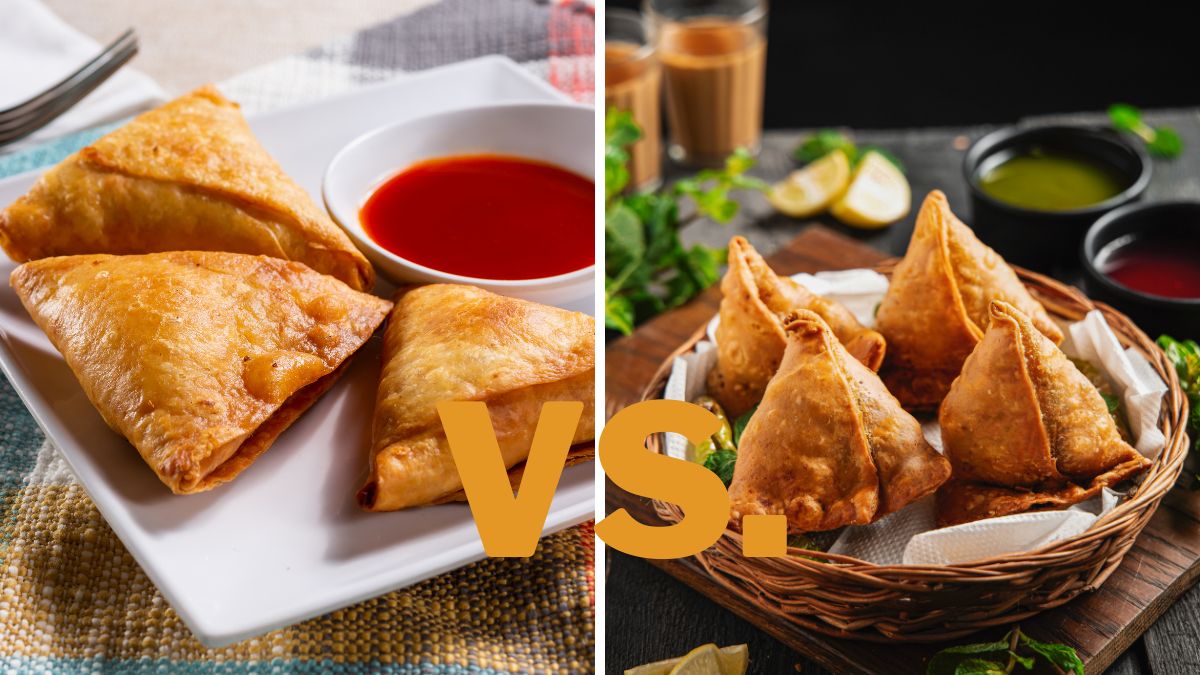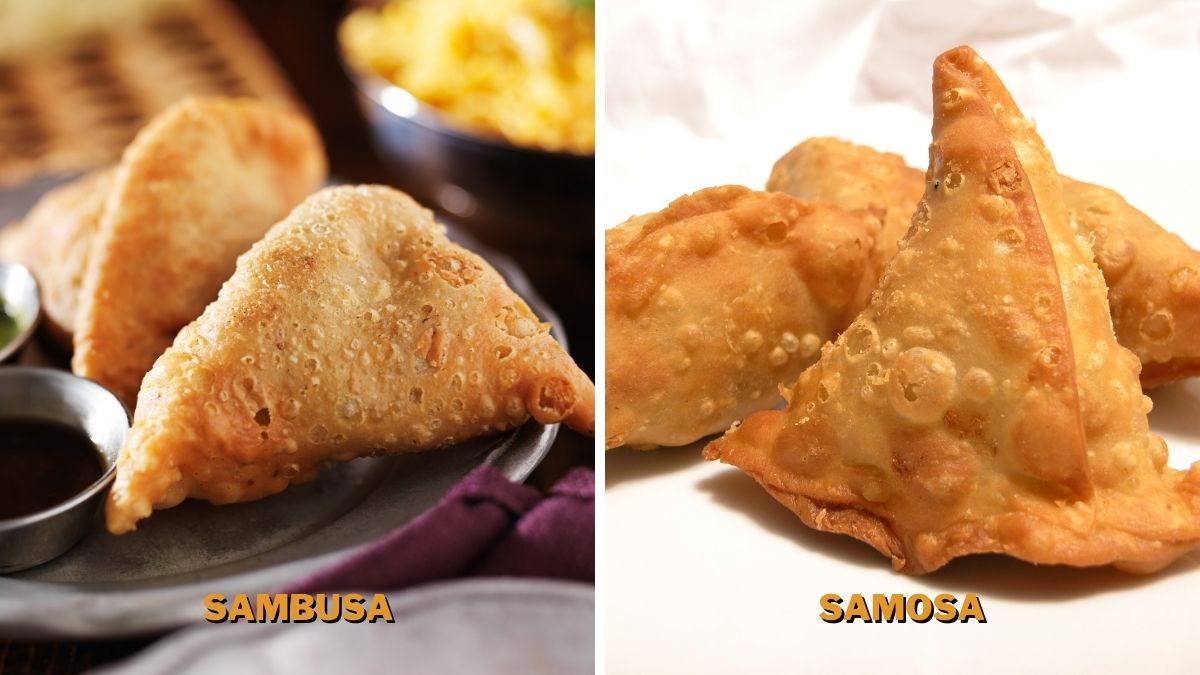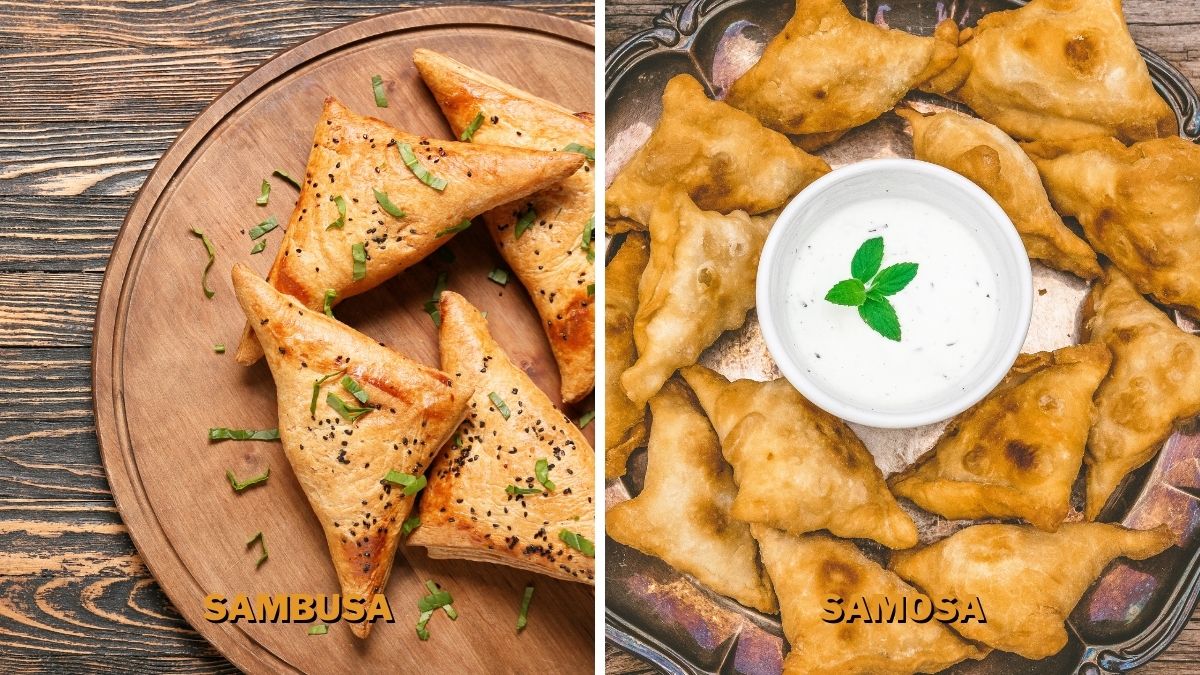Sambusa vs. Samosa: Differences Explained in Detail

Have you ever had a sambusa or samosa and wondered what the difference is? If so, you’re not alone — for a long time I thought they were the same thing. Then, while eating out, I saw that both were on the menu as two different things. So, although both are types of fried dough stuffed with filling, there are actually quite a few differences between them. There are lots to explore, from how they look and taste to how they’re prepared and served. So, what is the difference between sambusa and samosa?
Sambusa and samosa mainly differ in their appearance, type of dough, and taste. They are both prepared differently and served in distinct styles. They also have many variations, and sambusa appears to be more popular in some countries while samosa in others.
In this article, we’ll journey into the wonderful world of sambusa and samosa to discuss all the critical distinctions between these two popular cultural dishes from different parts of the world. Furthermore, we’ll also explore some variations that help make these delectable snacks even more delicious! So grab your passport, and let’s get started!
Origins
At first glance, the two may look like two peas in a pod, but they have some significant differences. To start, let’s discuss the origins of the sambusa.
In the Middle East and East Africa regions, this tasty treat is considered a national dish. Dating back to ancient times, sambusas are usually made from triangular-shaped dough filled with meat or cheese, spices, and vegetables. This savory snack is often served as an appetizer or side dish.
Samosa is a delicious, triangular-shaped savory pastry originating in the Indian subcontinent. It is typically filled with spiced potatoes, onions, and peas and served with chutney as a snack or appetizer. It’s usually made with a thin, flaky dough that is deep-fried until golden brown and puffy.
Appearance
On the surface, samosas are typically triangular in shape and can have a flaky, crisp appearance if deep-fried. But, depending on the region where they’re made, they can also vary in size and shape – some are cone-shaped, while others resemble pyramids!
Sambusas, on the other hand, can also have a half-moon shape with a dumpling or croissant-like texture that usually comes from being deep-fried.
However, both Samosas and Sambusas are triangles most of the time.

Dough
When it comes to dough, the biggest difference between these two delicacies is the dough type used. Sambusa typically uses a thinner, lighter dough that’s made from flour and water. The dough is rolled into thin circles and often fried or baked until it’s golden brown and crispy.
In comparison, samosa uses a heavier, thicker dough made from all-purpose flour, oil or ghee (clarified butter), salt, and water. This dough can be deep-fried or baked if desired. It has a flaky texture when cooked, and its durability makes it great for holding fillings such as vegetables, spiced potatoes, lentils, peas, onions, and more.
Filling and Spices
When discussing sambusa vs. samosa, filling and spices make the key distinction between the two. The fillings typically range from minced beef and lamb to potatoes, lentils, or even cheese. As for spices, sambusa will often include an array of Middle Eastern flavors like cumin, garlic, chili, and turmeric.
In comparison, the spices used in samosas will vary depending on the region of origin — in India or Pakistan, you may find coriander and garam marsala; in Bangladesh, you could get garlic and saffron; while in Africa, there may be chilies and allspice.
Though the spices do vary, both dishes will usually feature a combination of onions, ginger, garlic, and peppers in some form.
Taste
Sambusa has a sweeter taste with ingredients like sugar mixed in the dough, making for a sweeter dish overall. On the other hand, samosa has a savory flavor due to the spicier ingredients like chili peppers used in the dough.
Generally speaking, sambusas are milder in flavor than samosas due to using fewer or no spices in the filling. This leads to a different taste experience when you bite into it — while still satisfying your cravings for something crunchy at the same time!
Samosas’ flavor is more intense due to the higher amount of spices used in their preparation.
Ultimately, the taste is subjective, so the best way to explore these differences for yourself is to try these international dishes. For me, I prefer the spice kick in samosas more, but you can get the same kick by combining sambusas with your favorite sauces, so I love to enjoy both, but in other ways.
Preparation Method
Regarding the preparation method, sambusa tends to be larger than samosa and is served as an entree along with other dishes, while samosa is often served as an appetizer or snack.
While both varieties can be fried or baked, samosas are typically served fried, while sambusas can come either baked or fried.
Sambusa is most commonly made by folding the dough into triangles and sealing the edges. This is then filled with a savory filling, usually consisting of minced meat, onions, garlic, and other spices. It is then deep-fried in oil to cook it through before serving.
On the other hand, samosas are typically made by rolling out the dough into thin circles and then folding it over the filling mixture before deep-frying or baking them.
The dough used is usually thin and flaky, creating a crispier shell that can hold its shape better than sambusa when fried or baked. The filling for samosas can also vary widely, depending on regional preferences and the ingredients available.
Serving Style
Sambusas are usually served as individual pieces, whereas samosas are served in larger chunks, often shared amongst a group.
Additionally, whereas samosas are typically served with a chutney or a yogurt-based condiment due to their spicy filling, the fillings in sambusas tend to be savory rather than spicy. Therefore they are usually served plain or with a sprinkle of salt.

Variations
Of course, there are a few variations worth noting.
Sambusas can be filled with ground beef, chicken, or vegetables, but you can also find some filled with cheese and potatoes, like the South African sosatie.
Moreover, they also have regional variations regarding what types of fillings are used and how they’re prepared. For example, they may be pan-fried in Somalia using ghee instead of vegetable oil, giving them an even richer flavor.
In Saudi Arabia, dates might be added to the filling for sweetness, and other variations may include the addition of cheese or potatoes for a heartier filling.
When it comes to samosas, the Punjabi samosa, which is usually cooked in ghee and served with chutney or pickles, is very popular. And, of course, there’s the classic potato-pea version found throughout the Indian subcontinent.
You can’t go wrong no matter what variation you try — they’re all delicious!
Popularity
When it comes to popularity, the two snacks differ greatly. Samosas are wildly popular in India, Pakistan, Nepal, and Bangladesh. They are also beloved in African countries like Tanzania and Kenya. Sambusas can be found throughout Ethiopia, Somalia, and parts of the Middle East and North Africa, like Palestine, Syria, and Yemen.
Samosas have become popular worldwide due to Indian diaspora communities, with versions of their iconic snack available worldwide – from Europe to the Americas and Australia.
On the other hand, sambusas have seen less popularity outside their homeland, but they’re slowly gaining exposure as international travel becomes more accessible.
Whatever your preference is between the two, trust me, you’ll love both no matter which region of the world you find yourself in!
To sum up, I made a table to help you better understand their differences:
| Sambusa | Samosa |
|---|---|
| Deep-fried | Deep-fried or baked |
| Thinner, lighter dough | Heavier, thicker dough |
| Spices like cumin, garlic, chili, turmeric | Coriander, garam marsala, garlic, saffron |
| Sweeter, milder taste | Savory, more intense taste |
| Usually served as individual pieces | Usually served in larger chunks |
